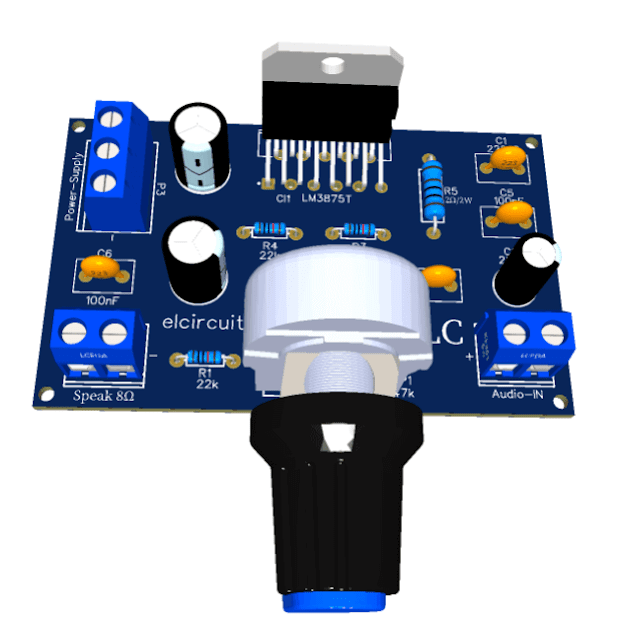 |
| Fig. 1 - 100W RMS Power Amplifier using 2 NPN 2SC5200 Output Transistors + PCB |
For Portuguese version, click here!
We usually have amplifiers with complementary outputs on most amplifier designs, and in a vast majority of amplifiers, it's quite normal to use the complementary NPN 2SC5200 transistors in conjunction with the PNP 2SA1943.
This type of amplifier is very common and good quality, because these transistors are specific for high fidelity amplification.
You might also be interested in:
- 400W Class AB Amplifier using MJL4281A and MJL4302A transistors + PCB
- Simple 100W Power Amplifier with TIP142 NPN and TIP147 PNP transistors + PCB
- 200W RMS Power Amplifier With 2SC2500 AND 2SA1943 + PCB
- 300W RMS Power Amplifier - 2SC3858 and 2SA1494 Transistors + PCB
- 50W RMS Audio Amplifier with IRF530 and IRF9530 Mosfet + PCB
- Simple 3 Transistors Power Amplifier push a 600W RMS Subwoofer + PCB
We'll build an amplifier circuit that uses the same concepts as two output transistors, but we will use two NPN 2SA5200 output transistors. Which is very interesting for those who like to test other types of transistors to evaluate the quality, distortions, powers. Etc.
The schematic diagram is in Figure 2 below, it is a simple amplifier, it has a satisfactory quality.
 |
| Fig. 2 - 100W RMS Power Amplifier with 2 NSC 2SC5200 Transistors at Output |
Power Supply
The power supply consists of a symmetrical transformer 32V - 0 - 32V center tape, with a current of 5 Amperes, a lower current, up to 3 Amperes minimum, can be used, which will play without any problems.
Nothing prevents you from using a higher or lower voltage, as this amplifier has a tolerance for the supply voltage, and can normally play “with small attenuation in the output power” with voltages ranging from 18V to 55V without too many difficulties.
It also has great stability, and we can use, if you have, a SMPS power supply, and this is clear with Center-Tape, that is to say a power supply with central socket.
Component List
- Q1, Q2 ............... Transistor A733
- Q3, Q4 ............... TIP41C transistor
- Q5 ...................... TIP42C transistor
- Q6, Q7 ............... 2SC5200 Power Transistor
- D1, D2, D3 ........ Diode 1N4007
- C1 ....................... 0.47uF Polyester capacitor
- C2, C4, C5 .......... 47uF - 63V electrolytic capacitor
- C3 ....................... 100nF ceramic / polyester capacitor
- C6 ....................... 150pF ceramic / polyester capacitor
- C7, C8 ................ 1nF ceramic / polyester capacitor
- R1 ....................... 22k ohms resistor (red, red, orange, gold)
- R2 ....................... 15k ohms resistor (brown, green, orange, gold)
- R3, R7 ................. 680 ohms resistor (blue, gray, brown, gold)
- R4 ....................... 33 ohms resistor (orange, orange, black, gold)
- R5 ....................... 560 ohms - 1W resistor (green, blue, brown, gold)
- R6 ....................... 56k ohms resistor (green, blue, orange, gold)
- R8, R9 ................ 4.7k ohms resistor (yellow, violet, red, gold)
- R10 ..................... 10 ohm resistor - (brown, black, black. gold)
- R11 ..................... 120 ohms - 1W resistor (brown, red, brown, gold)
- R12, R13 ............ 100 ohms - 1W resistor (brown, black, brown, gold)
- R14, R15 ............ 0.47 ohms - 5W resistor (yellow, violet, silver, gold)
- Others ................. PCB, Heat Sink, Loudspeaker, Wires, Solders, Etc.
For those who want to download materials such as the schematic diagram in PDF, PCB Layout, GERBER and JPG, we are providing a direct link to download all the material.
Direct link to download
Click in the link below to download the Files: PCB Layout, PDF, GERBER, JPG
If you have any questions, suggestions or corrections, please leave them in the comments and we will answer them soon.
Subscribe to our blog!!! Click here - elcircuits.com!!!
My Best Regards!!!



















